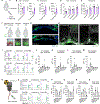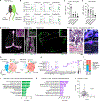Skull and vertebral bone marrow are myeloid cell reservoirs for the meninges and CNS parenchyma
- PMID: 34083447
- PMCID: PMC8863069
- DOI: 10.1126/science.abf7844
Skull and vertebral bone marrow are myeloid cell reservoirs for the meninges and CNS parenchyma
Abstract
The meninges are a membranous structure enveloping the central nervous system (CNS) that host a rich repertoire of immune cells mediating CNS immune surveillance. Here, we report that the mouse meninges contain a pool of monocytes and neutrophils supplied not from the blood but by adjacent skull and vertebral bone marrow. Under pathological conditions, including spinal cord injury and neuroinflammation, CNS-infiltrating myeloid cells can originate from brain borders and display transcriptional signatures distinct from their blood-derived counterparts. Thus, CNS borders are populated by myeloid cells from adjacent bone marrow niches, strategically placed to supply innate immune cells under homeostatic and pathological conditions. These findings call for a reinterpretation of immune-cell infiltration into the CNS during injury and autoimmunity and may inform future therapeutic approaches that harness meningeal immune cells.
Copyright © 2021 The Authors, some rights reserved; exclusive licensee American Association for the Advancement of Science. No claim to original U.S. Government Works.
Conflict of interest statement
Figures



Comment in
-
Private immune protection at the border of the central nervous system.Nature. 2021 Aug;596(7870):38-40. doi: 10.1038/d41586-021-01962-4. Nature. 2021. PMID: 34285399 No abstract available.
References
-
- Bassler K, Schulte-Schrepping J, Warnat-Herresthal S, Aschenbrenner AC, Schultze JL, The Myeloid Cell Compartment-Cell by Cell. Annu. Rev. Immunol 37, 269–293 (2019). - PubMed
-
- Guilliams M, Mildner A, Yona S, Developmental and functional heterogeneity of monocytes. Immunity 49, 595–613 (2018). - PubMed
-
- Ng LG, Ostuni R, Hidalgo A, Heterogeneity of neutrophils. Nat. Rev. Immunol 19, 255–265 (2019). - PubMed
Publication types
MeSH terms
Grants and funding
LinkOut - more resources
Full Text Sources
Other Literature Sources
Molecular Biology Databases
Miscellaneous

